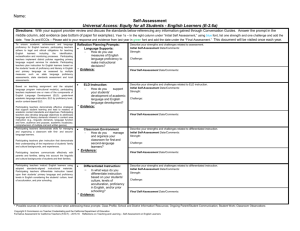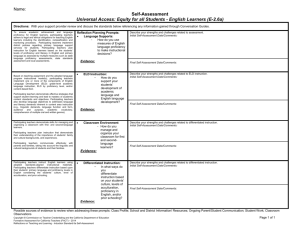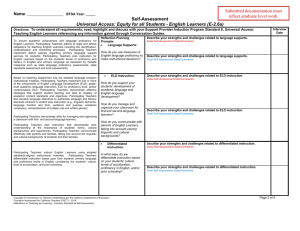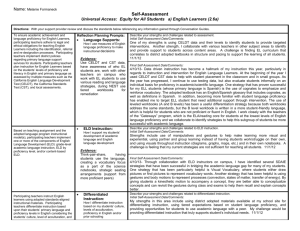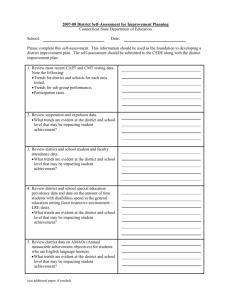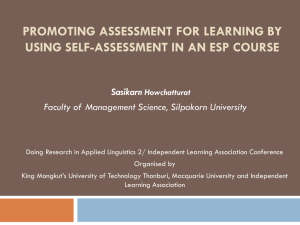Self-Assessment of Universal Access: Equity for all Students (E
advertisement
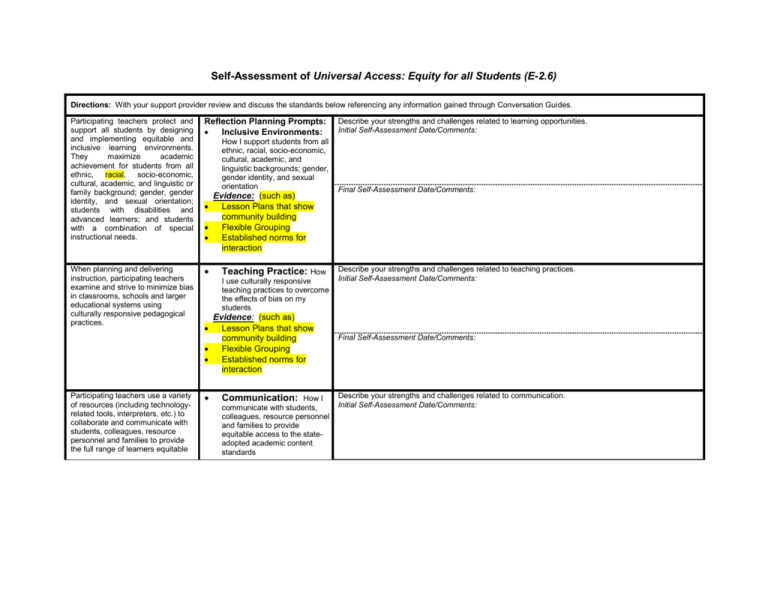
Self-Assessment of Universal Access: Equity for all Students (E-2.6) Directions: With your support provider review and discuss the standards below referencing any information gained through Conversation Guides. Participating teachers protect and support all students by designing and implementing equitable and inclusive learning environments. They maximize academic achievement for students from all ethnic, racial, socio-economic, cultural, academic, and linguistic or family background; gender, gender identity, and sexual orientation; students with disabilities and advanced learners; and students with a combination of special instructional needs. Reflection Planning Prompts: Inclusive Environments: When planning and delivering instruction, participating teachers examine and strive to minimize bias in classrooms, schools and larger educational systems using culturally responsive pedagogical practices. Participating teachers use a variety of resources (including technologyrelated tools, interpreters, etc.) to collaborate and communicate with students, colleagues, resource personnel and families to provide the full range of learners equitable How I support students from all ethnic, racial, socio-economic, cultural, academic, and linguistic backgrounds; gender, gender identity, and sexual orientation Evidence: (such as) Lesson Plans that show community building Flexible Grouping Established norms for interaction Teaching Practice: How I use culturally responsive teaching practices to overcome the effects of bias on my students Evidence: (such as) Lesson Plans that show community building Flexible Grouping Established norms for interaction Describe your strengths and challenges related to learning opportunities. Initial Self-Assessment Date/Comments: Final Self-Assessment Date/Comments: Describe your strengths and challenges related to teaching practices. Initial Self-Assessment Date/Comments: Communication: How I communicate with students, colleagues, resource personnel and families to provide equitable access to the stateadopted academic content standards Final Self-Assessment Date/Comments: Describe your strengths and challenges related to communication. Initial Self-Assessment Date/Comments: access to the state-adopted academic content standards. Evidence: (such as) Use of School Loop to communicate with students and families Online learning tools for research, review Home/school Log Translated documents Final Self-Assessment Date/Comments: Possible sources of evidence to review when addressing these prompts: Class Profile; School and District Information/ Resources; Ongoing Parent/Student Communication; Student Work; Classroom Observations Self-Assessment of Universal Access: Equity for All Students - English Learners (E-2.6a) Directions: With your support provider review and discuss the standards below referencing any information gained through Conversation Guides. To ensure academic achievement and language proficiency for English Learners, participating teachers adhere to legal and ethical obligations for teaching English Learners including the identification, referral and redesignation processes. Participating teachers implement district policies regarding primary language support services for students. Participating teachers plan instruction for English Learners based on the students’ levels of proficiency and literacy in English and primary language as assessed by multiple measures such as the California English Language Development Test (CELDT), the California Standards Test (CST), and local assessments. Based on teaching assignment and the adopted language program instructional model(s), participating teachers implement one or more of the components of English Language Development (ELD): grade-level academic language instruction, ELD by Reflection Planning Prompts: Describe your strengths and challenges related to assessment. Initial Self-Assessment Date/Comments: Language Supports: How I use measures of English language proficiency to make instructional decisions Final Self-Assessment Date/Comments: Evidence: (such as) Lesson Plans Evidence of collaboration with EL coordinator Training on how to interpret assessment data ELD Instruction: How I support my students’ development of academic language and English language development Evidence: (such as) Describe your strengths and challenges related to ELD instruction. Initial Self-Assessment Date/Comments: proficiency level, and/or content-based ELD. Participating teachers instruct English learners using adopted standardsaligned instructional materials. Participating teachers differentiate instruction based upon their students’ primary language and proficiency levels in English considering the students’ culture, level of acculturation, and prior schooling. ELD standards posted and addressed in lesson plans classroom layout Flexible grouping Differentiated Instruction: How I differentiate instruction based on my students’ culture, levels of acculturation, proficiency in English and/or prior schooling Evidence: (such as) Lesson Plans Student Projects/Work Use of SIOP, etc. strategies Final Self-Assessment Date/Comments: Describe your strengths and challenges related to differentiated instruction. Initial Self-Assessment Date/Comments: Final Self-Assessment Date/Comments: Possible sources of evidence to review when addressing these prompts: Class Profile; School and District Information/ Resources; Ongoing Parent/Student Communication; Student Work; Classroom Observations Copyright © Commission on Teacher Credentialing and the California Department of Education Formative Assessment for California Teachers (FACT) – 2011 Reflections on Teaching and Learning - Induction Standard 6a Self-Assessment
